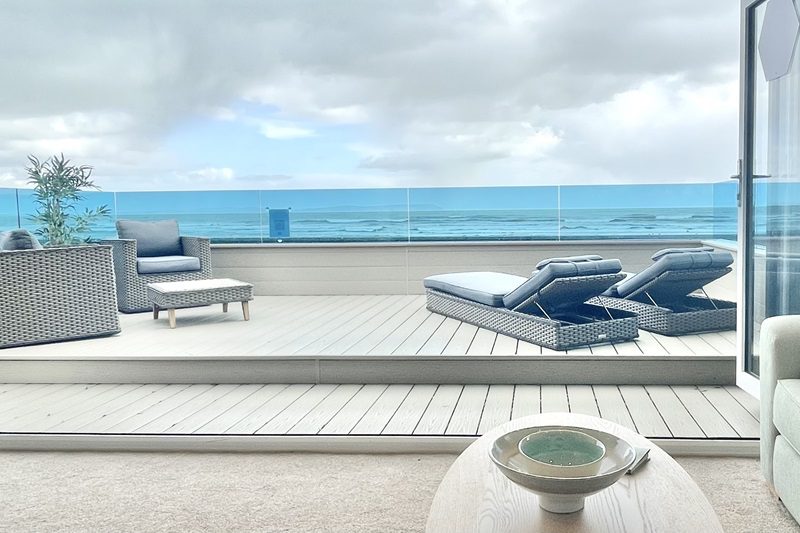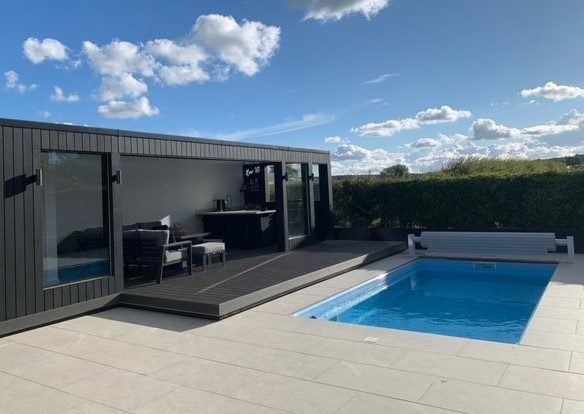Timber has traditionally been the go-to material of choice for decking boards. However, there’s now a wealth of alternative decking materials on the market, meaning homeowners can look beyond wood and embrace different options.
In this blog we look at the pros and cons of each material, helping you decide which option is right for you.
Composite decking
Composite decking is a much more durable alternative to timber decking, made from a combination of recycled and sustainably-sourced wood and plastic fibres. Unlike timber, it doesn’t rot and requires very little upkeep.
Advantages of composite decking
- Extremely durable and long lasting, and often comes with a lengthy warranty
- Low slip potential making it safe and comfortable underfoot
- Split and splinter resistant making it safe and stylish for longer
- Available in a wide range of traditional colours such as brown composite decking and contemporary colours like black and grey composite decking.
- Perfectly emulates real timber
- A sustainable choice – especially if you choose Ecodek composite decking. Our decking is made from 95% recycled and sustainably-sourced materials and can be recycled at the end of its life
- Very low maintenance, requiring no treatments to protect it from the elements, and only the occasional wash.
Disadvantages of composite decking
- Can be more expensive than timber but remember to look at the lifetime cost of your choice – you may find composite is more cost effective, as it will last much longer!
- Must be installed correctly to ensure it doesn’t bow or sag. If you’re installing your composite decking yourself, always follow the manufacturer’s instructions to ensure the correct expansion gaps and amount of supports.
- There are varying degrees of quality when it comes to composite decking – so choose carefully. Options vary from cheaper, imported hollow decking, through to UK-made solid boards, often with longer warranties. Ecodek boards are manufactured here in the UK so we can guarantee quality, supported by a UK-based customer service team.
PVC decking
PVC decking and wide PVC decking is different to composite decking in that it’s made from a completely synthetic material. Although hollow, a well-made PVC board will be long-lasting and durable.
Advantages of PVC decking
- Does not rot, split or splinter like timber decking
- Cheaper than many deck board alternatives
- Available in a range of colours and styles
- Easy to install
- Low maintenance
- Safe and comfortable underfoot.
Disadvantages of PVC decking
- Not as sustainable or environmentally-friendly as composite decking, however, look out for PVC decking that can be recycled
- Can fade over time if exposed to excessive sunlight.

Bamboo decking
Bamboo may not be the most obvious choice of material for a decking, but its characteristics are very similar to natural wood, which makes for a compelling alternative.
Advantages of bamboo decking
- Durable, lightweight, and resilient
- Easy to work with and install
- Offers a natural wood-like finish, similar to that of traditional timber.
Disadvantages of bamboo decking
- As with wood, bamboo decking is susceptible to rot, mildew, and mould
- Its natural colour can fade over time, again similar to natural wood
- Very high maintenance, requiring regular care to prevent deterioration.
Aluminium decking
Aluminium decking is one of the lightest weight decking alternatives available. It’s particularly suited to use on balconies and refurbishment projects where flooring needs to adhere to stringent fire regulations. Our range of aluminium decking, Adek, is non-combustible, A2fl-s1/A2-s1, d0 fire rated, making it the perfect choice for both new and refurbished high-rise buildings.
Advantages of aluminium decking
- One of the longest lasting wood decking alternatives
- Offers a contemporary and stylish finish
- Non-combustible A2fl-s1/A2-s1, d0 fire rated
- Easy to maintain
- Eco-friendly, as aluminium is a very sustainable material, that can be recycled and re-used over and over again.
Disadvantages of aluminium decking
- Is not easy to install, especially at height, and requires the skills of a professional
- Expensive
- Limited number of colours and styles available.

Alternatives to decking
If you’re looking for something different to decking, here’s some of the options available:
Natural stone paving
Natural stone paving is a good alternative to wood decking and most commonly made from limestone, sandstone, or granite.
Advantages of natural paving
- Beautiful and decorative, with each slab having its own unique design due to the nature of stone
- Hardwearing and durable.
Advantages of natural paving
- Heavy and difficult to manoeuvre
- Requires professional installation due to weight
- Is an expensive option compared to timber and other wood alternatives
- Needs a flat, solid base on which to be laid, which can affect your timeline and budget.

Concrete paving slabs
Concrete paving slabs are designed to emulate the look of real stone or brick, but at a fraction of the cost.
Advantages of concrete paving slabs
- A cheaper alternative to other types of paving such as natural stone or porcelain
- Semi-permeable, which allows water to seep through the slabs rather than pooling on top.
Disadvantages of concrete paving slabs
- The porous nature of the material means it can stain very easily
- Concrete slabs can crack and break easily under pressure, so are not as durable as some of the other wood decking alternatives
- When replacing, new concrete slabs can look different to older ones which can create a mismatched look.
Poured concrete
Poured concrete is a good way of creating a patio at a fraction of the cost. A more expensive option is to have your concrete imprinted or stamped. This involves laying concrete and forming shapes or patterns that replicate the look of slabs, bricks, or tiles. You may have seen it used on driveways, but can also be used in gardens.
Advantages of poured concrete
- Cost effective (if simply laying concrete)
- There are no gaps through which unwanted weeds can grow
- You can choose the size and design, making it completely unique to you and your garden.
Disadvantages of poured concrete
- Prevents easy access to utilities
- Can leave an uneven finish if the base is not completely flat
- It may be prone to cracks.
Decking tiles
Interlocking decking tiles can be made from a variety of different materials, usually composite, wood and sometimes stone, and fit together like a jigsaw puzzle.
Advantages of decking tiles
- Can be used to create unique designs, so are ideal for irregular shaped areas
- Easy to install by DIYers
- Simple to replace a tile should one become damaged
- Can be used to cover an existing decked or patioed area.
Disadvantages of decking tiles
- Often more expensive than wood, PVC and composite deck boards
- If you’re not laying the tiles directly on to an old platform, you may have to create a foundation, which will impact both your timeline and budget.
Rubber paved tiles
Rubber paved tiles are made from high density rubber which results in an extremely durable surface.
Advantages of rubber paved tiles
- Slip resistant and durable so can handle heavy footfall traffic
- Long lasting
- The elasticity of the material makes it very comfortable underfoot. This soft, spongy finish makes rubber paved tiles perfect for kids’ play areas
- Easy to maintain.
Disadvantages of rubber paved tiles
- Rubber paved tiles can be expensive
- They need to be laid on completely flat ground to ensure an even surface – they’re not very forgiving!
- Not aesthetically attractive
Discover our composite decking collections
As the UK’s leading composite decking manufacturer, we obviously believe that composite decking is one of the best timber decking alternatives. If you’d like to test this theory, call our friendly, knowledgeable team today on 01978 667 840 or email enquiries@ecodek.co.uk for a no obligation chat.
